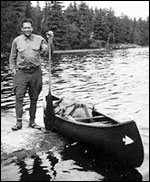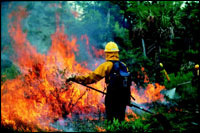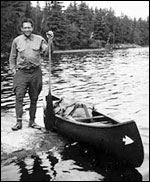At 3:30 in the morning, on July 15, 1932, 31-year-old Bob Marshall started walking. His goal: to see how many peaks in the Adirondack Mountains he could scale in one day. At 1 p.m., he met up with Herb Clark, an old family friend, at the summit of Mount Marcy, the highest mountain in the range. Clark was with a young architect named Paul Schaefer. More than 30 years later, looking back on the encounter, Schaefer could vividly recall his impression that Marshall’s eyes “reflected a great joy for living.”

Bob Marshall.
Photo: The Wilderness
Society.
Marshall had recently returned from a long sojourn in Alaska, and as Schaefer described the various logging and development projects that had transpired in the Adirondacks in his absence, Marshall grew upset and restless. “We simply must band together,” he said, “all of us who love the wilderness. We must fight together — wherever and whenever the wilderness is attacked.” The men shook hands, and Marshall took off, literally running down the mountain. At day’s end, he had climbed 14 peaks. Three years later, Schaefer received an invitation to join the Wilderness Society, a newly formed organization with the mission of protecting the nation’s wilderness.
Schaefer’s recollection of the meeting on Mount Marcy turns out to be an emblematic anecdote in the remarkable life of Bob Marshall, for it suggests Marshall’s deep commitment to preservation, his dedication to the founding of a movement, and his near-freakish physical energy. (Marshall’s biographer, James Glover, notes that Marshall routinely dashed off on 35-mile day hikes throughout his adult life). That it takes place on a mountaintop, in the company of an old friend and a new one, is all the more fitting; if there was one thing Marshall cared for as much as wilderness, it was society — the society of his friends, and a just American society.
As an activist-bureaucrat in the departments of Agriculture and the Interior, Marshall was a bulldog for preservation both publicly and behind the scenes. Perhaps as much as any one person, his efforts, energy, and example (not to mention his money; he was the sole financial angel of the Wilderness Society in its early years) lead to the passage of the Wilderness Act of 1964. That act designated over 9 million acres as wilderness areas in perpetuity, and paved the way (he would not appreciate the metaphor) for millions more.
Although it’s hard to know when he found the time, Marshall was also a writer: At the time of his Adirondack hiking marathon, he had already penned the influential 1930 essay “The Problem of the Wilderness,” was putting the finishing touches on the first of two bestsellers on life in the Arctic, and was about to begin writing his share of the U.S. Forest Service’s massive National Plan for American Forestry. From his research for the latter tome emerged a book on forestry, first published in 1933 and recently reissued by the University of Iowa Press with a new forward and introduction. The People’s Forests lays out the problems that were facing America’s forests in the 1930s and proposes a radical solution: the public acquisition and administration of nearly all forestland in the United States.
One Nation, One Forest Management Plan?
Born into privilege and comfort in New York City, the son of one of the nation’s most prominent constitutional lawyers (Louis Marshall argued more cases before the Supreme Court than anyone besides solicitors general), Marshall nonetheless craved the outdoors and the thrill of exploration. He often lamented that he was born a century too late, and avidly read the exploits of Lewis and Clark. He attended the New York State College of Forestry at Syracuse, earned a masters in forestry from Harvard, and worked for three years at the Northern Rocky Mountain Forest Experiment Station on the Idaho-Montana border before returning to the East Coast to complete a Ph.D. in plant physiology at Johns Hopkins. He was politically liberal by nurture — his father was a prominent civil-rights advocate before the term existed — and became a socialist while doing his graduate work in Baltimore. (His beliefs would lead him to fight Jim Crow policies in Forest Service recreation areas in the South and to advocate bus service to national forests and parks for the inner-city poor.)

The People’s Forests
By Robert Marshall
University of Iowa
Press, 233 pages,
2002
Marshall entered the environmental fray at a pivotal moment in the movement’s history. Conservation is, historically and etymologically, a conservative doctrine. But by the 1930s, what most political conservatives wished to conserve were the laissez-faire business practices of the nineteenth century, not the resources or the landscapes that those practices so relentlessly depredated. During the first third of the 20th century, as conservation increasingly came in direct conflict with big business, the political ground shifted until conservation’s chief advocates came overwhelmingly from the left.
Because The People’s Forests was published in the midst of the Great Depression and the New Deal, when alternatives to market capitalism actually seemed viable, the book’s central suggestion — the socialization of nearly all private forestland in the U.S. — was not so terribly beyond the pale. Nor, however, did it have any chance of being adopted. Marshall was by no means a commanding political theorist; his book won no more converts to socialism in 1933 than it will today. However sincerely he believed that blanket public ownership was the best way to ensure both the sustainability of the forest industry and the preservation of wilderness, the book was meant mostly as a catalyst to debate. So said the New York Times Book Review, which was certain that the book would “stir its readers to fresh consideration” and “help greatly in rousing public attention and sentiment.”
Taken out of the context of its time, The People’s Forests is generally a disappointing read. (Marshall himself later viewed it as something of a rush job.) Several of the arguments are simply too facile and lack supporting evidence. The book also suffers from the inherent difficulty of writing compelling prose about board-feet, erosion, slash piles, and regulation — hardly page-turning topics under the best of circumstances, and even less likely to stand the literary test of time. Marshall’s best writing is found in his uncollected magazine articles, but there are a few instances in The People’s Forests when his pen rises to the occasion, especially when his subject is the aesthetic and intellectual experience of the forest:
Anyone who has looked across a ghostly valley at midnight, when moonlight makes a formless silver unity out of the drifting fog, knows how impossible it often is in nature to distinguish mass from hallucination. Anyone who has stood upon a lofty summit and gazed over an inchoate tangle of deep canyons and cragged mountains, of sunlit lakelets and black expanses of forest, has become aware of a certain giddy sensation that there are no distances, no measures, simply unrelated matter rising and falling without any analogy to the banal geometry of breadth, thickness, and height.
Such lyric interludes aside, what is most interesting about The People’s Forests is its reappearance at this particular time — in the Era of the Forest Fire, and at a moment when the environmental movement is suddenly being forced to revisit some basic assumptions about its relationship with the federal government.
A Burning Question
Environmentalists have grown accustomed to working with the federal government; that is the legacy of the Wilderness Act, the Clean Air Act, the Clean Water Act, the Endangered Species Act, the National Forest Management Act, the Comprehensive Environmental Response, Compensation, and Liability Act, and so forth. That is to say, we have become accustomed to a government that — however much it must be prodded, litigated, or shamed — has done something to protect the health and welfare of its people, animals, and plants; a government that has been willing to get its hands dirty in issues of soil quality, in air pollution, in species preservation; and to see this accumulation of knowledge slowly, haltingly, but eventually transformed into policy. Readers of this magazine may view this as a right, not a privilege, but the federal government’s willingness to listen to environmental science seems increasingly shaky.
Take, for example, the Bush administration’s stance on forestry policy. Armed with night after night of footage of Western forests — more than 7 million acres of them — burning cinematically for the 11 o’clock news, the Bush administration has promised to alter forest management by fiat, in the name of “common sense.” But common sense is a funny thing. The common sense of a Texas oilman may not seem so commonsensical to, say, an Oregon forest biologist. (Or an Oregon lawmaker, for that matter; outgoing Gov. John Kitzhaber (D) was incensed that the Bush administration decided to override a new forest management plan drawn up by 10 Western governors and signed by the president last May).

Fire! Fire! Fire!.
Photo: White House.
Clearly, Bush is right that there are problems with the current state of fire prevention on federal lands. The basic problem is well known: We have gotten so good at quelling small fires (largely to prevent flames from consuming houses and other developments that should never have been built in such ecologically sensitive areas in the first place) that fuel builds up to the point where conflagrations become uncontrollable. The federal government has not been able to practice controlled burns at a level anywhere near what would be required to significantly reduce the instances of major, devastating fires. One could blame this on funding troubles, or on the difficulties involved with coordinating numerous federal agencies. Or, alternatively, one could blame the meddling public for its desire to have a say in the management of, well, public lands.
That’s been the tack of the Bush administration, which has essentially blamed last summer’s fires on environmentalists for preventing logging sales in many parts of the West. Instead of adhering to the Western governors’ plan, instead of intently focusing on communities at high risk from forest fires, the Bush plan leaves it to the discretion of local managers to determine whether or not proposed logging operations throughout the national system will have environmental impact, and allows for logging and thinning to take place even while appeals are being heard. That would be comical jurisprudence if it weren’t so chilling.
All this should give one pause about the validity of Marshall’s thesis in the present climate. If the federal government’s environmental track record is cause for alarm, should that government have total control over the nation’s forestland? Marshall proposed socialized forest management because he was (rightly) suspicious of the inordinate power of big commerce in local politics. Now that commerce appears to have such unchecked influence in national politics, the environmental movement finds itself in between a giant rock (the federal government) and myriad hard places. As the Bush administration tries to devolve responsibility for forest management onto local communities and private entities, conservationists may need to take a page out of the old conservative handbook and redouble their efforts in the hardest places of all: local bureaucracies and private landholdings. (The rise of land conservancies and land trusts is an indication of just such a trend.)
If the people spoke on election night, right now might not be the People’s Forests’ shining hour. But for that very reason, it might be a particularly good moment to resurrect The People’s Forests. The book might not be a masterpiece, but it’s a welcome occasion for the recollection of a conservationist who thought unconventionally and acted vigorously, as well as a timely spur to thinking about where conservation came from, where it should go from here, and how best to get there.
If Bob Marshall was in a hurry that day in the Adirondacks, and every day, it was because he believed that wilderness, once lost, is likely never regained. From this vantage point, it is also tempting to speculate that he sensed his own time was limited. On November 10, 1939, after a dinner with friends in Washington, D.C., Marshall caught a midnight train for New York City. He was found dead in his berth after the train pulled in to Pennsylvania Station. No cause of death was ever established; he was 38 years old.


